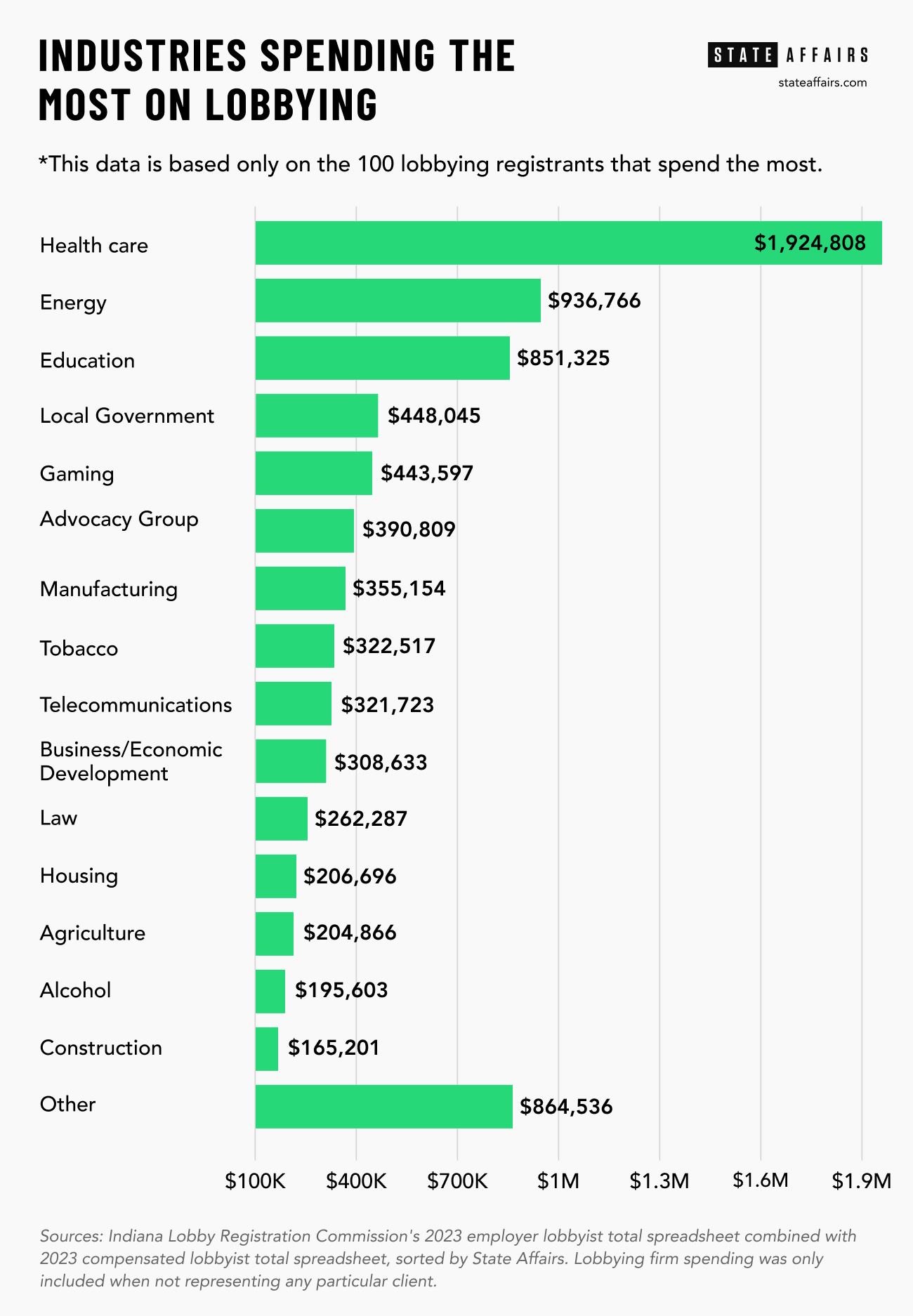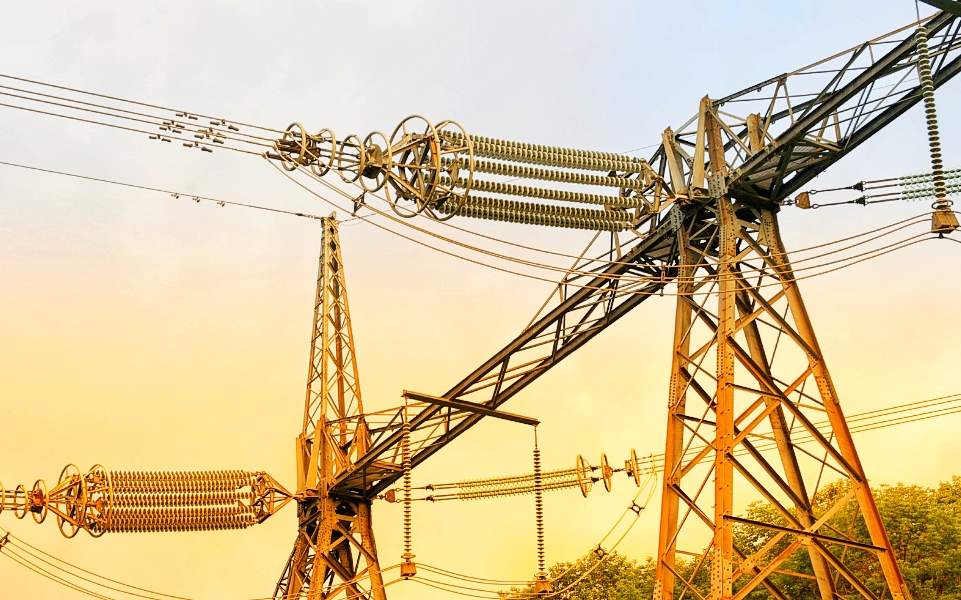
- Lobbyists in the health care, energy and education industries generally spent the most on lobbying this past reporting period.
- Hoosiers for Quality Education, which advocated for more funding for charter schools, reported spending the most on lobbying efforts.
- Out of the top 5 self-representing lobbyists with the largest wallets this past legislative session, four came from the health care industry.
Editor’s note: This article is part of a series regarding influence in the Indiana Statehouse. Read more about which lawmakers received the most entertainment during the legislative session here.
By nearly all metrics, school choice advocates walked away from the 2023 legislative session as winners.
Lawmakers approved a massive expansion of the state-funded voucher system, enabling roughly 97% of Indiana students to use state money to attend the school of their choice. Likewise, charter schools will receive millions of dollars in future years, in some cases siphoning away money historically dedicated to traditional public schools.
One clue as to why school choice advocates were successful this year could be in the data compiled and recently released by the Indiana Lobby Registration Commission showing how much each lobbyist spent trying to persuade lawmakers between Nov. 1, 2022, through April 30, 2023 — the period covering the most recent legislative session.
Hoosiers for Quality Education, a school choice advocacy group, and its affiliate reported spending a combined $433,754 on lobbying over the course of six months, hundreds of thousands more than any organization spent lobbying for their own interests. Most of that stemmed from spending on a massive public-facing advertising campaign arguing that charter school students were being unfairly underfunded.
As part of a series tracking Statehouse influence, State Affairs sorted through lobbying data to determine which groups and industries reported spending the most. Altogether, lobbyists spent $20.7 million compensating lawyers, purchasing facetime via pricey meals and professional sporting event tickets or pursuing other lobbying-related expenditures, based on numbers provided by the commission at the close of June.
Out of the top 100 registered lobbyists representing their own organizations, those in the health care, energy and education industries spent the most.

Lawmakers rely on lobbyists for information on how laws will impact different professions or the well-being of Hoosiers. In fact, more than a thousand organizations and companies have filed with the lobbying commission, including some consumer advocates for Hoosiers in poverty or seniors.
“These guys are part-time legislators,” Betsy Wiley, president of Hoosiers for Quality Education, said. “They are not experts in health care, utilities, K-12 education, higher ed, welfare, corrections, DNR. They can’t possibly be, nor can their staff, so they have to find trusted resources to give them data and information to help them make an informed decision.”
But many of the top 100 biggest spenders came from industries that stand to gain or be harmed financially by the laws legislators pass, including those in state-regulated industries such as alcohol or gaming. The State Affairs analysis provides a window into who has enough resources to influence change at the Statehouse. Of course, there are other ways to attempt to garner influence that don’t show up in these numbers, including through campaign contributions.
“You’re talking about really, really large companies that just have enormous resources and deep pockets and with that comes an enormous amount of influence and access,” said Kerwin Olson, executive director of the consumer advocacy group Citizens Action Coalition.
The analysis also showed inconsistencies in which expenditures organizations and companies report as lobbying expenses, which means it’s challenging for every day Hoosiers to track who is actually spending the most money influencing lawmakers. It also might not capture all of the session-related spending if lobbyists were compensated after the fact due to the timeline of the reporting periods.
Top 10 lobbying spenders
- Hoosiers for Quality Education, Inc.: $390,238
- Indiana State Medical Association: $230,638
- Indiana Farm Bureau Inc.: $204,866
- Indiana Hospital Association: $193,700
- Indiana University Health (IU Health): $156,558
- Greater Indianapolis Chamber of Commerce: $151,623
- Duke Energy Indiana LLC: $146,318
- St. Vincent Health, Inc: $142,157
- Americans for Prosperity: $127,416
- AFT Indiana: $126,645
Source: Indiana Lobby Registration Commission’s 2023 employer lobbyist total spreadsheet combined with 2023 compensated lobbyist total spreadsheet, sorted by State Affairs. Lobbying firms with diverse clients were excluded.
How the education debate was impacted
Education spending makes up more than half of the state budget, which means lobbyists were unsurprised the industry as a whole spent more than most others. This year lawmakers not only dramatically expanded school choice, but they also pursued a host of other education-related bills, including those that increase work-based learning in schools, prohibit the teaching of human sexuality in K-3rd grade and reduce the power of teacher unions.
Hoosiers for Quality Education might have topped the list in part due to vagueness surrounding when advertising spending needs to be reported as a lobbying expenditure. The group claimed roughly $380,000 for an ad blitz on behalf of the Indiana Student Funding Alliance, which included a call to “close the gap” between funding for traditional public school students and those who attend charters.
“I’d rather air on the side of transparency,” Wiley from Hoosiers for Quality Education said of the decision to include the advertising spend in the lobbying reports. “I would rather over report than under report, so we just reported it all.”
Previously, only traditional public schools received local property tax dollars, while charter schools had to rely solely on state money. That led to a lack of parity between the two, Wiley said.

Because of changes in Senate Bill 391 and the budget — which was supported by Hoosiers for Quality Education, traditional schools in four counties will be required to share future referendum tax levy dollars and other property tax growth with brick and mortar charter schools in the area. Had the referendum sharing requirement alone been in effect in 2022, charter schools in those areas would have received $23.9 million in local taxes that otherwise would have been allocated to traditional public schools, according to an analysis from the state’s Legislative Services Agency. The state also increased its own spending on charter schools.
AFT Indiana, one of the groups representing teachers, also landed in the top 10 lobbyists representing their own interests, spending $126,645, the majority of which went toward paying lobbyists, according to records.
Sally Sloan, executive director of AFT Indiana, left a message for State Affairs saying the organization’s report was inaccurate and would be corrected, but didn’t return multiple followup calls seeking clarification.
Health care industry dominated top 100 spenders
When looking at the top 100 lobbyists, those from the health care industry spent the most — $1.92 million, or more than double what any other industry spent.
Out of the top 5 self-representing lobbyists with the largest wallets this past legislative session, three came from the health care industry. That’s unsurprising given the legislative leaders’ focus on health care-related issues this past legislative session, including increasing public and mental health spending and cutting health care costs for consumers.
The Indiana State Medical Association (ISMA), which represents physicians, spent the second most when excluding traditional lobbying firms with diverse clients, dedicating $230,638 toward its lobbying efforts. The majority of that funding went toward paying lobbyists, but ISMA spent an additional $14,786 on entertainment for lawmakers. The bulk of that entertainment spending came from a dinner hosted for all Senate and House health committee members, a spokesman for ISMA said.
The group, which declined an interview request, lobbied for enhancements to the state’s trauma care system and measures they argued would reduce costs, such as limits on physician noncompete clauses and a reduction in prior authorization requirements.
Such legislation passed, but in some cases with restrictive caveats. For example, as Senate Bill 7 crossed the finish line, it banned noncompetes for primary care physicians only.
Hospitals, which occasionally found themselves at odds with the goals of ISMA throughout the legislative session, weren’t far behind in spending. The Indiana Hospital Association ranked No. 4, spending $193,700, followed by Indiana University Health, which spent $156,558. St. Vincent Health, otherwise known as Ascension, ranked No. 8, spending $142,157.
All three were on defense much of the legislative session as lawmakers threatened to implement price caps in an effort to lower costs at the biggest hospital systems.
Lawmakers didn’t implement price caps, but they did pass legislation requiring nonprofit hospital systems to charge for services based on where the service is actually provided and implementing other reporting requirements. Advocates argued the initiative will lower health care prices, but hospitals warned it will have unintended consequences.
Brian Tabor, IHA president, called the bill “an unprecedented picking of winners and losers within an industry.”
Energy industry pays big
Following health care, spending by the energy and utility industry made up the next biggest category when looking at the top 100 lobbyists.
Duke Energy Indiana, an electric and natural gas company, ranked No. 7, spending $146,318 in the first reporting period of the year, mostly on its own lobbyists or reimbursing others.
Angeline Protogere, a spokesperson for Duke Energy, emphasized that the company complies with all lobbying laws.
“In Indiana, Duke Energy serves 69 counties, and we provide background and education on utility issues to not only legislators representing those counties, but across the entire state,” Protogere said in a statement.

Meanwhile, the Indiana Energy Association, which advocates for utility companies, topped a different list by spending $45,613 on entertainment-related expenses, the fourth-highest spend on entertainment for lawmakers. The association spent $33,182 on at least one unspecified function every lawmaker was invited to and more than $11,000 on tickets and refreshments for sporting events for 22 lawmakers and some of their family members. Half of those lawmakers sit on committees passing laws regarding utilities or the environment.
“Advocacy is centered around issues affecting the energy transition and what it means for our customers and their constituents,” Danielle McGrath, president of IEA, said. “Given the complexity of our issues and the speed at which things are changing, it’s imperative to communicate on the issues and provide opportunities for others to learn and ask questions.”
Olson, from Citizens Action Coalition, called the legislative session “one of the most successful sessions in a very long time,” for utility companies.
House Bill 1420, for example, allows the state’s existing utility companies, such as Duke Energy, to have first dibs on potentially billions of dollars worth of new electricity transmission lines. Likewise, House Bill 1421 enables utility companies to charge ratepayers for projects associated with natural gas before the infrastructure comes online.
“The influence and the reach of utilities was extraordinary,” Olson said. “The results speak for themselves.”
Other prolific spenders
The Indiana Farm Bureau and The Greater Indianapolis Chamber of Commerce, known as the Indy Chamber, also ranked high on the list, coming in at No. 3 and 6, respectively.
A majority of the Indiana Farm Bureau’s $204,866 lobbying expenditures came from compensating lobbyists. But the organization also spent $44,900 on at least one event every lawmaker was invited to and $10,798 worth of other entertainment and gifts.
Top 10 gift and entertainment providers
1. Accelerate Indiana Municipalities: $69,185
2. Indiana Farm Bureau Inc.: $55,701
3. Indiana Manufacturers Association: $55,636
4. Indiana Energy Association, Inc: $45,613
5. Indiana Association of Realtors: $37,500
6. The Corydon Group: $29,927*
*non-client expenditures plus reports listing The Corydon Group as a client
7. Indiana Electric Cooperatives: $27,889
8. Association of Indiana Prosecuting Attorneys, Inc.: $27,063
9. Krieg DeVault LLP: $25,115*
*non-client expenses plus reports listing Krieg DeVault as a client
10. Bose Public Affairs Group LLC: $21,829*
*non-client expenses plus reports listing Bose Public Affairs Group as a client
Source: Indiana Lobby Registration Commission’s 2023 employer lobbyist total spreadsheet combined with entertainment and gift expenditures on behalf of clients listed on the 2023 compensated lobbyist total spreadsheet, sorted by State Affairs.
The organization, which represents 260,000 member-families, focuses on issues that impact agriculture and rural communities. This past legislative session it weighed in on everything from property taxes to utilities to public health funding. It did not respond to a request for an interview.
Meanwhile, the Indy Chamber reported spending $151,623 on lobbying, the majority of which was for paying lobbyists. Unlike some other organizations, the chamber includes the total salary for its two staff lobbyists in that figure, despite it only making up a portion of thost staff members’ jobs. The chamber, which represents businesses and economic development in central Indiana, also provided $726-worth of Pacers suite tickets to lawmakers.
“With the Indy Chamber being headquartered in Indianapolis and representing the businesses of the nine-county Indy region,” said Adam Burtner, vice president of government affairs for Indy Chamber, “it’s important to ensure legislators from across the state who are here during legislative session can experience what makes Indy the economic driver of the state, including showcasing the events and cultural assets only Downtown Indianapolis can offer.”
Americans for Prosperity, an influential political advocacy group that often contributes to Republican campaigns, also ranked in the top 10, spending $127,416 on its lobbying efforts. Josh Webb, Indiana state director for Americans for Prosperity, said the organization lobbied in favor of expanding the school voucher program and supported many of the major health care cost-cutting bills in their final form this year. The organization is trying to increase its lobbying presence in Indiana.
“We’re not really there to serve any one special interest or one group,” Webb said. “We’re really there to advance these principles of freedom that we believe in.”
The largest ‘entertainment’ providers
Some lobbyists relied more than others on providing entertainment to lawmakers, but it’s challenging to get a complete picture of who was really treating lawmakers the most due to differences in how each lobbyist reports entertainment expenditures.
Big name lobbying firms would have topped the entertainment-providing list, but State Affairs counted entertainment and gifts purchased on behalf of a client toward the client’s total. Still, some groups like Corydon Group, which paid for lawmakers to eat and golf while on out-of-state trips to Hawaii and Arizona, graced the top 10 list when including entertainment not attributable to any particular client.
Accelerate Indiana Municipalities, which speaks on behalf of more than 460 cities and towns, was associated with the highest dollar amount of entertainment in the last reporting period: $69,185. But most of that, the organization said, was due to one $65,000 legislative dinner every lawmaker was invited to.
That number was the total cost of the event and included the expenditures of others in attendance, such as leaders of cities and towns who capitalized on the opportunity to speak with the lawmakers. Some organizations appear to only report the cost associated with the lawmakers.
“We try to be obviously meticulous in our reporting and err on the side of transparency, so I guess we’re a little confused on what the reporting process is for everyone else as well,” said Matt Greller, chief executive officer of AIM. “We’re not the only ones who have these big dinners.”
The Indiana Manufacturers Association, which was associated with $55,636 worth of entertainment spending, shared a similar story. The organization, too, has one high-priced legislative reception each year in which every lawmaker is invited. Andrew Berger, senior vice president of governmental affairs for the Indiana Manufacturers Association, said the majority of people at the event are IMA members. But, the trade organization still reports the cost of the entire event.
“I know there’s events that are not showing up on those reports. I don’t know why; I don’t want to speculate on what other people do,” Berger said. “But I’m confident we’re doing it the right way.”
Neither organization shared specific examples of organizations reporting large functions differently.
Still, both argued the receptions — and lobbying in general — were vital to achieving their goals.
“The lobbying team here at the IMA are well known at the Statehouse,” Berger said. “But the best lobbyists for a trade association like us are our members, the people who actually are paying the taxes, are hiring people in Indiana or paying health care costs.”
Contact Kaitlin Lange on Twitter @kaitlin_lange or email her at Kaitlin@stateaffairs.com.
Twitter @StateAffairsIN
Facebook @stateaffairsin
Instagram @stateaffairsin
LinkedIn @stateaffairs
Header image credit: Brittney Phan

Add new comment